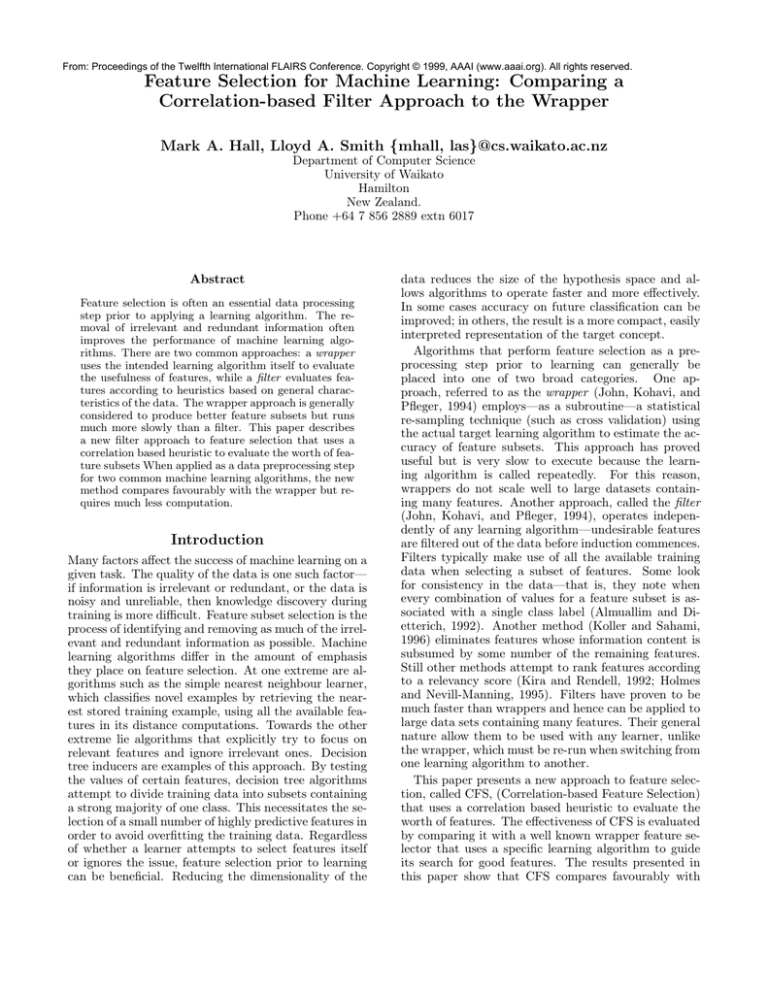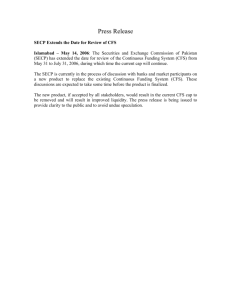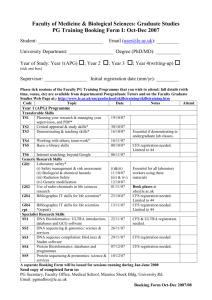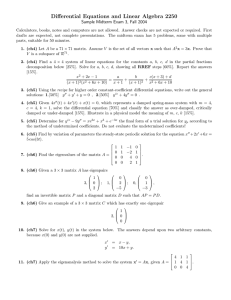
From: Proceedings of the Twelfth International FLAIRS Conference. Copyright © 1999, AAAI (www.aaai.org). All rights reserved.
Feature Selection for Machine Learning: Comparing a
Correlation-based Filter Approach to the Wrapper
Mark A. Hall, Lloyd A. Smith {mhall, las}@cs.waikato.ac.nz
Department of Computer Science
University of Waikato
Hamilton
New Zealand.
Phone +64 7 856 2889 extn 6017
Abstract
Feature selection is often an essential data processing
step prior to applying a learning algorithm. The removal of irrelevant and redundant information often
improves the performance of machine learning algorithms. There are two common approaches: a wrapper
uses the intended learning algorithm itself to evaluate
the usefulness of features, while a filter evaluates features according to heuristics based on general characteristics of the data. The wrapper approach is generally
considered to produce better feature subsets but runs
much more slowly than a filter. This paper describes
a new filter approach to feature selection that uses a
correlation based heuristic to evaluate the worth of feature subsets When applied as a data preprocessing step
for two common machine learning algorithms, the new
method compares favourably with the wrapper but requires much less computation.
Introduction
Many factors affect the success of machine learning on a
given task. The quality of the data is one such factor—
if information is irrelevant or redundant, or the data is
noisy and unreliable, then knowledge discovery during
training is more difficult. Feature subset selection is the
process of identifying and removing as much of the irrelevant and redundant information as possible. Machine
learning algorithms differ in the amount of emphasis
they place on feature selection. At one extreme are algorithms such as the simple nearest neighbour learner,
which classifies novel examples by retrieving the nearest stored training example, using all the available features in its distance computations. Towards the other
extreme lie algorithms that explicitly try to focus on
relevant features and ignore irrelevant ones. Decision
tree inducers are examples of this approach. By testing
the values of certain features, decision tree algorithms
attempt to divide training data into subsets containing
a strong majority of one class. This necessitates the selection of a small number of highly predictive features in
order to avoid overfitting the training data. Regardless
of whether a learner attempts to select features itself
or ignores the issue, feature selection prior to learning
can be beneficial. Reducing the dimensionality of the
data reduces the size of the hypothesis space and allows algorithms to operate faster and more effectively.
In some cases accuracy on future classification can be
improved; in others, the result is a more compact, easily
interpreted representation of the target concept.
Algorithms that perform feature selection as a preprocessing step prior to learning can generally be
placed into one of two broad categories. One approach, referred to as the wrapper (John, Kohavi, and
Pfleger, 1994) employs—as a subroutine—a statistical
re-sampling technique (such as cross validation) using
the actual target learning algorithm to estimate the accuracy of feature subsets. This approach has proved
useful but is very slow to execute because the learning algorithm is called repeatedly. For this reason,
wrappers do not scale well to large datasets containing many features. Another approach, called the filter
(John, Kohavi, and Pfleger, 1994), operates independently of any learning algorithm—undesirable features
are filtered out of the data before induction commences.
Filters typically make use of all the available training
data when selecting a subset of features. Some look
for consistency in the data—that is, they note when
every combination of values for a feature subset is associated with a single class label (Almuallim and Dietterich, 1992). Another method (Koller and Sahami,
1996) eliminates features whose information content is
subsumed by some number of the remaining features.
Still other methods attempt to rank features according
to a relevancy score (Kira and Rendell, 1992; Holmes
and Nevill-Manning, 1995). Filters have proven to be
much faster than wrappers and hence can be applied to
large data sets containing many features. Their general
nature allow them to be used with any learner, unlike
the wrapper, which must be re-run when switching from
one learning algorithm to another.
This paper presents a new approach to feature selection, called CFS, (Correlation-based Feature Selection)
that uses a correlation based heuristic to evaluate the
worth of features. The effectiveness of CFS is evaluated
by comparing it with a well known wrapper feature selector that uses a specific learning algorithm to guide
its search for good features. The results presented in
this paper show that CFS compares favourably with
The amount by which the entropy of Y decreases reflects the additional information about Y provided by
X and is called the information gain (Quinlan, 1993).
Information gain is given by
the wrapper but requires far less computation.
CFS: Correlation-based Feature
Selection
Feature evaluation
At the heart of the CFS algorithm is a heuristic for evaluating the worth or merit of a subset of features. This
heuristic takes into account the usefulness of individual
features for predicting the class label along with the
level of intercorrelation among them. The hypothesis
on which the heuristic is based can be stated:
Good feature subsets contain features highly correlated
with (predictive of ) the class, yet uncorrelated with
(not predictive of ) each other.
In test theory (Ghiselli, 1964), the same principle is
used to design a composite test for predicting an external variable of interest. In this situation, the “features”
are individual tests which measure traits related to the
variable of interest (class).
Equation 1 (Ghiselli, 1964) formalises the heuristic:
krcf
M erits = p
k + k(k − 1)rf f
Feature Correlations
Classification tasks in machine learning often involve
learning from categorical features, as well those that are
continuous or ordinal. In order to have a common basis
for computing the correlations necessary for Equation
1, continuous features are transformed to categorical
features in a preprocessing step using the supervised
discretisation method of Fayyad and Irani (1993). A
measure based on information theory estimates the degree of association between nominal features.
If X and Y are discrete random variables, Equations
2 and 3 give the entropy of Y before and after observing
X.
X
p(y)log2 p(y),
(2)
H(Y ) = −
y∈Y
X
x∈X
p(x)
X
y∈Y
p(y|x)log2 p(y|x).
= H(Y ) − H(Y |X)
= H(X) − H(X|Y )
= H(Y ) + H(X) − H(X, Y ).
(3)
(4)
Information gain is a symmetrical measure—that is,
the amount of information gained about Y after observing X is equal to the amount of information gained
about X after observing Y . Unfortunately, information
gain is biased in favour of features with more values,
that is, attributes with greater numbers of values will
appear to gain more information than those with fewer
values even if they are actually no more informative.
Furthermore, the correlations in Equation 1 should be
normalized to ensure they are comparable and have
the same effect. Symmetrical uncertainty (Press et al.
1988) compensates for information gain’s bias toward
attributes with more values and normalises its value to
the range [0, 1]:
(1)
where M eritS is the heuristic “merit” of a feature
subset S containing k features, rcf is the mean featureclass correlation (f ∈ S), and rf f is the average featurefeature intercorrelation. Equation1 is, in fact, Pearson’s
correlation, where all variables have been standardised.
The numerator can be thought of as giving an indication of how predictive of the class a group of features
are; the denominator of how much redundancy there is
among them. The heuristic handles irrelevant features
as they will be poor predictors of the class. Redundant attributes are discriminated against as they will
be highly correlated with one or more of the other features.
H(Y |X) = −
gain
·
symmetrical uncertainty = 2.0×
gain
H(Y ) + H(X)
¸
(5)
Searching the Feature Subset Space
The purpose of feature selection is to decide which of
the initial features to include in the final subset and
which to ignore. If there are n possible features initially,
then there are 2n possible subsets. The only way to find
the best subset would be to try them all—this is clearly
prohibitive for all but a small number of initial features.
Various heuristic search strategies such as hill climbing and best first (Rich and Knight, 1991) are often
applied to search the feature subset space in reasonable
time. CFS starts from the empty set of features and
uses a forward best first search with a stopping criterion of five consecutive fully expanded non-improving
subsets. Best first search is also the preferred search
strategy to use with the wrapper (Kohavi, 1995).
Applying CFS to Machine Learning
Problems
Figure 1 shows the stages of the CFS algorithm and
how it is used in conjunction with a machine learning algorithm. A copy of the training data is first discretized using the method of Fayyad and Irani (1993),
then passed to CFS. CFS calculates feature-class and
feature-feature correlations using symmetrical uncertainty and then searches the feature subset space. The
subset with the highest merit (as measured by Equation 1) found during the search is used to reduce the
dimensionality of both the original training data and
the testing data. Both reduced datasets may then be
passed to a machine learning algorithm for training and
testing.
Figure 1: The components of CFS.
Baye’s classifier’s predictive performance can be adversely affected by the presence of redundant features
in the training data.
C4.5 (Quinlan, 1993) is an algorithm that summarises
the training data in the form of a decision tree. Along
with systems that induce logical rules, decision tree algorithms have proved popular in practice. This is due
in part to their robustness and execution speed, and to
the fact that explicit concept descriptions are produced,
which users can interpret.
C4.5 “grows” decision trees recursively, using a
greedy approach to decide which attributes to test at
the nodes of the tree. An information theoretic measure similar to symmetric uncertainty guides the process. C4.5 can sometimes overfit training data, resulting in large trees. In many cases, feature selection can
result in C4.5 producing smaller trees.
Wrapper Feature Selection
Locally Predictive Features
Because correlations are estimated globally (over all
training instances), CFS tends to select a “core” subset of features that has low redundancy and is strongly
predictive of the class. In some cases however, there
may be subsidiary features that are locally predictive
in a small area of the instance space. CFS includes a
heuristic to include locally predictive features and avoid
the re-introduction of redundancy.
Experimental Results
Experiments with the basic version of CFS described
above have shown that it can be of use to machine
learning algorithms in terms of improving accuracy and
comprehensibility of induced models (Hall and Smith,
1998; Hall 1998). In this paper we look at how CFS
compares with a well known wrapper feature selector.
This section present the results of experiments designed
to compare the performance of common machine learning algorithms after feature selection by CFS with their
performance after feature selection by the wrapper. In
particular, the accuracy of learners and the size of models produced after feature selection are compared. In
addition, the execution time of CFS is compared with
the wrapper.
Machine Learning Algorithms
Two machine learning algorithms representing two
diverse approaches to learning were used in the
experiments—a probabilistic learner (naive Bayes) and
a decision tree learner (C4.5).
Naive Bayes employs a simplified version of Bayes
formula to classify each novel example. The posterior
probability of each possible class is calculated using conditional probabilities for feature values and prior probabilities of classes estimated from the training data; each
novel instance is assigned the class with the highest
posterior probability. Due to the assumption that feature values are independent given the class, the naive
The MLC++ machine learning library (Kohavi et al.
1994) was used to provide results for the wrapper. Tenfold cross validation of the training data was used to
provide an estimate of the accuracy of feature sets with
respect to a particular learning algorithm. The same
search strategy and stopping criterion as CFS are employed by the wrapper.
Experiments
Twelve standard datasets drawn from the UCI collection (Merz and Murphy, 1996) were used in the experiments: they are summarised in Table 1. These datasets
were chosen because of the prevalence of nominal features and their predominance in the literature. Three
of the datasets (australian, lymphography, and horsecolic) contain a few continuous features; the rest contain
only nominal features.
Fifty runs were done for each machine learning algorithm on each dataset with features selected by CFS
and by the wrapper. In each run, a dataset was randomly split into a training and testing set (sizes given in
Table 1). CFS and the wrapper were applied in turn to
the full training set to select features. Separate training
and testing sets consisting of features selected by CFS
and features selected by the wrapper were created and
each machine learning algorithm was applied to these
dimensionally reduced datasets.
Table 2 shows the results of feature selection for naive
Bayes; results for naive Bayes with no feature selection
(All features) are shown as well. Accuracies give the
percentage of correct classifications, averaged over the
fifty trials. Results for CFS are shown in bold if they
show significant improvement over the corresponding
result for the wrapper, and vice versa. A “+” or “−”
sign shows where results for CFS are significantly better or worse than when no feature selection is performed
(all the features are used), and similarly for the wrapper. Throughout, we speak of results being “significantly different” if the difference is statistically different
at the 5% level according to a paired two-sided t-test.
Table 1: Datasets used in the experiments
Dataset
Features
Max/min
Classes
test size
values
mushroom
23
12/1
Train
size/
feature
2
1000/7124
vote
17
2/2
2
218/217
vote1
16
2/2
2
218/217
australian
16
23/2
2
228/462
lymph
19
8/2
4
98/50
primary-tumor
18
3/2
23
226/113
breast-cancer
10
11/2
2
191/95
dna-promoters
56
4/4
2
69/37
audiology
70
6/2
24
149/77
soybean
36
7/2
19
450/223
horse-colic
28
346/2
2
242/126
kr-vs-kp
37
3/2
2
2110/1086
Similarly, Table 3 shows the results of feature selection for C4.5.
Table 2: Accuracy of naive Bayes with feature selection
by CFS and the wrapper.
Dataset
CFS
Wrapper
mushroom
98.53+
98.86+
All features
94.75
vote
95.20+
95.24+
90.25
cases. CFS, on the other hand, does not need to reserve
part of the training data for evaluation purposes, and,
in general, tends to do better on smaller datasets than
the wrapper.
Figure 2 shows how feature selection by the wrapper and the CFS affects the size of the trees induced
by C4.5. Bars below the zero line indicate that feature selection has reduced the size of the trees. The
graph shows that both feature selectors reduce the size
of the trees induced by C4.5 more often than not. The
wrapper tends to result in somewhat smaller trees than
CFS.
Figure 3 shows the average number of features selected on each dataset by the wrapper using naive Bayes
and by CFS. CFS generally selects a similar sized feature set as the wrapper1 . In many cases the number of
features is reduced by more than half by both methods.
CFS executes many times faster than the wrapper.
On a Sparc server 1000, a single trial took one cpu
unit or less to complete for all datasets except kr-vskp, which averaged 8 cpu units. By comparison, the
wrapper ranged from 123 cpu units to complete one trial
on breast-cancer to over 9000 cpu units to complete one
trial on kr-vs-kp. The wrapper is cubic in the number
of features, whereas CFS is squared in the number of
features.
vote1
89.51+
88.95+
87.20
australian
85.90+
85.16+
78.21
lymph
83.92+
76.00−
82.12
Dataset
CFS
Wrapper
primary-tumor
46.73
42.32−
46.87
mushroom
98.55−
99.03−
99.59
breast-cancer
72.06
70.96−
72.16
vote
95.39
95.33
95.23
dna-promoters
90.58
82.05−
89.21
vote
88.66
87.82−
88.71
audiology
75.04−
79.33
80.24
australian
85.89+
84.75+
83.69
soybean
92.69+
92.99+
91.30
lymph
76.67
80.86+
75.80
horse-colic
86.24+
87.70+
83.13
primary-tumor
41.00
39.53−
40.99
kr-vs-kp
94.24+
94.36+
87.33
breast-cancer
70.97
71.11
71.77
dna-promoters
76.89+
74.21
74.58
audiology
77.60
75.50−
78.48
Discussion of Results
soybean
88.88
89.65
89.16
CFS outperforms the wrapper four times for naive
Bayes and five times for C4.5, while the wrapper outperforms CFS three times for both learning algorithms.
Furthermore, as shown by the entries marked with “+”
or “−” in the tables, CFS improves the accuracy of the
learning algorithms more times and degrades accuracy
fewer times than the wrapper does. For naive Bayes,
CFS improves accuracy eight times and degrades accuracy only once; the wrapper improves accuracy seven
times but degrades accuracy four times. For C4.5,
CFS improves accuracy twice and degrades accuracy
twice; the wrapper improves accuracy three times but
degrades accuracy five times.
It appears that the wrapper has some difficulty on
datasets with fewer examples. Cross validation accuracy estimates can exhibit greater variability when
the number of examples is small (Kohavi, 1995), and
the wrapper may be overfitting these datasets in some
horse-colic
84.79
85.56+
84.02
kr-vs-kp
94.23−
97.19−
99.16
Table 3: Accuracy of C4.5 with feature selection by
CFS and the wrapper.
All features
Conclusion
This paper has presented a correlation-based approach
to feature selection for machine learning and compared
it with the wrapper—a well known feature selection
technique that uses the target learning algorithm to
guide its search for good features. The experiments
have shown that, in many cases, CFS gives results that
are comparable or better than the wrapper. Because
CFS makes use of all the training data at once, it can
1
The number of features selected by the wrapper using
C4.5 is very similar. Note that because CFS is a filter, the
feature sets it selects are the same regardless of the final
learning algorithm.
give better results than the wrapper on small datasets.
CFS is much faster than the wrapper (by more than an
order of magnitude), which allows it to be applied to
larger datasets than the wrapper.
Many applications of machine learning involve predicting a “class” that takes on a continuous numeric
value. Future work will aim at extending CFS to handle problems where the class is numeric.
Fayyad, U. M. and Irani, K. B. 1993. Multi-interval
Discretisation of Continuous-valued Attributes for Classification learning. In Proceedings of the Thirteenth International Joint Conference on Artificial Intelligence.
Morgan Kaufmann.
Ghiselli, E. E. 1964. Theory of Psychological Measurement. McGraw-Hill.
Hall, M. A. 1998. Correlation-based Feature Selection
for Machine Learning. Ph.D diss. Dept. of Computer
Science, Waikato Univ.
Hall, M. A. and Smith, L. A. 1998. Practical Feature
Subset Selection For Machine Learning. In Proceedings
of the 21st Australasian Computer Science Conference,
181–191. Springer.
Holmes, G. and Nevill-Manning, C. G. 1995. Feature Selection via the Discovery of Simple Classification
Rules. In Proceedings of the International Symposium
on Intelligent Data Analysis.
John, G. H.; Kohavi, R.; and Pfleger, P. 1994. Irrelevant Features and the Subset Selection Problem. In
Machine Learning: Proceedings of the Eleventh International Conference. Morgan Kaufmann.
Figure 2: Average change in the size of the trees induced
by C4.5 when features are selected by the wrapper (left)
and CFS (right).
Kira, K. and Rendell, L. 1992. A Practical Approach
to Feature Selection. In Machine Learning: Proceedings
of the Ninth International Conference. Morgan Kaufmann.
Kohavi, R. 1995. Wrappers for Performance Enhancement and Oblivious Decision Graphs. Ph.D diss. Dept.
of Computer Science, Stanford Univ.
Kohavi, R.; John, G.; Long, R.; Manley, D.; and
Pfleger, K. 1994. MLC++: A machine learning library
in C++. In Tools with Artificial Intelligence, 740–743.
IEEE Computer Society Press
Koller, D. and Sahami, M. 1996. Towards Optimal Feature Selection. In Machine Learning: Proceedings of the
Thirteenth International Conference, 294–292. Morgan
Kaufmann.
Merz, C. J. and Murphy, P. M. 1996.
UCI
Repository
of
Machine
Learning
Data-bases
[http://www.ics.edu/˜mlearn/MLRepository.html].
Irvine Calif.: Univ. of Calif., Dept. of Information
Science.
Figure 3: Number of features selected by the wrapper
using naive Bayes (left) and CFS (right). Dots show
the number of features in the original dataset.
References
Almuallim, H. and Dietterich, T. G. 1992. Efficient
Algorithms for Identifying Relevant Features. In Proceedings of the Ninth Canadian Conference on Artificial
Intelligence, 38–45. Morgan Kaufmann.
Press, W. H.; Flannery, B. P.; Teukolski, S. A.; and
Vetterling, W. T. 1988. Numerical Recipes in C. Cambridge University Press.
Quinlan, J. R. 1993. C4.5: Programs for Machine
Learning. Morgan Kaufmann.
Rich, E. and Knight, K. 1991. Artificial Intelligence.
McGraw-Hill.





